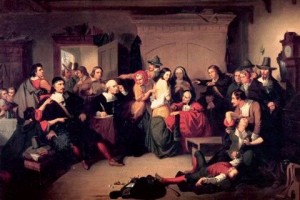How Many Burnt in the Burning Years? April 8, 2012
Author: Beach Combing | in : Medieval, Modern , trackbackBeachcombing has made fun in the past of historians and numbers: be they numbers for the population of Britain in Roman times or numbers of prisoners taken by the barbary pirates. Most historical numbers are simply partial facts or very partial facts multiplied by guesses. A classic example of this are the numbers of ‘witches’ killed in Europe from 1450 to 1750. Here estimates have ranged from the simply extraordinary nine million to the more sober-sounding thirty thousand.
When any historical debate ranges across this kind of terrain: you can be sure that you are in statistical cloud cuckoo land. And, in fact, the nine million number, that had its origins in the (early) feminist movement and was repeated by such recent feminists as the well-meaning but ‘angry’ Andrea Dworkin, has absolutely no basis in any kind of reality. This number if true would mean a simply incredible 30,000 witches being killed every year for three centuries.
The only sensible way to produce an estimate is, instead, to come up with reliable archives and to start bean counting. This sounds tedious and efficient until you remember that there are huge holes in our evidence: as certain periods and certain places lack documentation, for instance, Sweden and Poland throughout this period. But this doesn’t mean that men and women were not put to death in these less documented areas. It just begs the question: how many?
The only solution at that point is to extrapolate about the ‘holes’. But, of course, there were huge regional differences that make extrapolation difficult. For example, in Iceland most executed witches were men rather than women. In Ireland and parts of Highland Scotland witchcraft trials never really caught on. In Spain witch-hunters were limited and usually careful: in Switzerland and parts of what is today Germany they went a little mad and many died.
Clearly extrapolations across a continent and across three centuries with variations like these cause huge problems. The ‘witchcraft’ community has coalesced to some extent around figures offered up by the scholar Brian Levack in his The Witch-Hunt in Early Modern Europe: BL talks of perhaps 110,000 arrests and 60,000 deaths from 1450-1750, about two hundred a year. But the only true numbers are the 10,000-15,000 recorded cases in surviving European documents.
For Beach the real tragedy here is that witchcraft scholars have so obsessed about numbers and accompanying sociology – why did they kill these people? – that the, at least as interesting, question of the beliefs behind witchcraft (real and/or imagined) has been neglected. It is a shame as thoughts on belief can at least be based squarely on evidence.
Beach is always on the look out for violence done to statistics by historians: drbeachcombing AT yahoo DOT com



